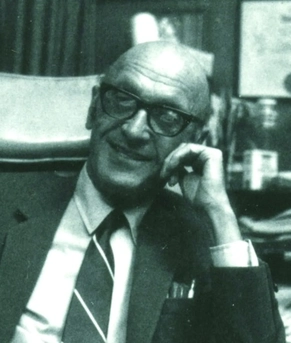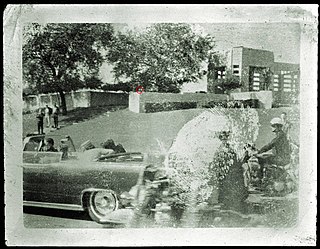
Jack Leon Ruby was an American nightclub owner who killed Lee Harvey Oswald on November 24, 1963, two days after Oswald was accused of assassinating President John F. Kennedy. Ruby shot and mortally wounded Oswald on live television in the basement of Dallas Police Headquarters and was immediately arrested.

Lee Harvey Oswald was a U.S. Marine veteran who assassinated John F. Kennedy, the 35th president of the United States, on November 22, 1963.

The President's Commission on the Assassination of President Kennedy, known unofficially as the Warren Commission, was established by President Lyndon B. Johnson through Executive Order 11130 on November 29, 1963, to investigate the assassination of United States President John F. Kennedy that had taken place on November 22, 1963.

On November 22, 1963, John F. Kennedy, the 35th president of the United States, was assassinated while riding in a presidential motorcade through Dealey Plaza in Dallas, Texas. Kennedy was in the vehicle with his wife Jacqueline, Texas Governor John Connally, and Connally's wife Nellie, when he was fatally shot from the nearby Texas School Book Depository by Lee Harvey Oswald, a former U.S. Marine. The motorcade rushed to Parkland Memorial Hospital, where Kennedy was pronounced dead about 30 minutes after the shooting; Connally was also wounded in the attack but recovered. Vice President Lyndon B. Johnson was hastily sworn in as president two hours and eight minutes later aboard Air Force One at Dallas Love Field.

Dealey Plaza is a city park in the West End Historic District of downtown Dallas, Texas. It is sometimes called the "birthplace of Dallas". It was also the location of the assassination of John F. Kennedy in 1963. Thirty minutes after the shooting, Kennedy was pronounced dead at Parkland Memorial Hospital. The Dealey Plaza Historic District was named a National Historic Landmark on the 30th anniversary of the assassination, to preserve Dealey Plaza, street rights-of-way, buildings, and structures by the plaza visible from the assassination site, that have been identified as witness locations or as possible locations for the assassin.

Abraham Zapruder was a Ukrainian-born American clothing manufacturer who witnessed the assassination of United States President John F. Kennedy in Dallas, Texas, on November 22, 1963. He unexpectedly captured the shooting in a home movie while filming the presidential limousine and motorcade as it traveled through Dealey Plaza. The Zapruder film is regarded as the most complete footage of the assassination.

J. D. Tippit was an American World War II U.S. Army veteran and Bronze Star recipient, who was a police officer with the Dallas Police Department for 11 years. About 45 minutes after the assassination of John F. Kennedy on November 22, 1963, Tippit was shot and killed in a residential neighborhood in the Oak Cliff section of Dallas, Texas, by Lee Harvey Oswald. Oswald was initially arrested for the murder of Tippit and was subsequently charged with killing President Kennedy. Oswald was murdered by Jack Ruby, a Dallas nightclub owner, two days later.
James Thomas Tague was a car salesman who received minor injuries during the assassination of United States President John F. Kennedy in Dallas, Texas, on November 22, 1963. Tague received a minor wound to his right cheek caused by tiny pieces of concrete debris from a street curb that was struck by fragments from a bullet that was fired at Kennedy. Besides Kennedy and Texas Governor John Connally, Tague was the only other person known to have been struck as a result of gunfire at Dallas's Dealey Plaza that day.
Lee Edward Bowers Jr. was a witness to the assassination of United States President John F. Kennedy in Dallas, Texas on November 22, 1963. The timing and circumstances of Bowers's death have led to various allegations that his demise was part of a cover-up subsequent to the Kennedy murder.
Ruth Hyde Paine was a former friend of Marina Oswald, who was living with her at the time of the JFK assassination. According to official government investigations, including the Warren Commission, Lee Harvey Oswald stored the 6.5 mm caliber Carcano rifle used to shoot U.S. President John F. Kennedy in Ruth Paine's garage, unbeknownst to her and her husband, Michael Paine.

This article outlines the timeline of events before, during, and after the assassination of John F. Kennedy, the 35th president of the United States.

The Badge Man is a figure that is purportedly present within the Mary Moorman photograph of the assassination of United States president John F. Kennedy in Dealey Plaza on November 22, 1963. Conspiracy theorists have suggested that this figure is a sniper firing a weapon at the president from the grassy knoll. Although a reputed muzzle flash obscures much of the detail, the Badge Man has been described as a person wearing a police uniform—the moniker itself derives from a bright spot on the chest, which is said to resemble a gleaming badge.
On November 22, 1963, John F. Kennedy, the 35th President of the United States, was assassinated using a 6.5×52mm Carcano Model 38 long-barrelled rifle.

James William "Ike" Altgens was an American photojournalist, photo editor, and field reporter for the Associated Press (AP) based in Dallas, Texas, who became known for his photographic work during the assassination of United States President John F. Kennedy (JFK). Altgens was 19 when he began his AP career, which was interrupted by military service during World War II. When his service time ended, Altgens returned to Dallas and got married. He soon went back to work for the local AP bureau and eventually earned a position as a senior editor.

Howard Leslie Brennan was an American memoirist and steamfitter who was witness to the assassination of United States President John F. Kennedy in Dallas, Texas on November 22, 1963. According to the Warren Commission, Brennan's description of a sniper he saw was probative in reaching the conclusion that the shots came from the sixth floor, southeast corner window of the Texas School Book Depository Building.

James Robert Leavelle was a Dallas Police Department homicide detective who, on November 24, 1963, was escorting Lee Harvey Oswald through the basement of Dallas Police headquarters when Oswald was shot by Jack Ruby. Leavelle prominently was noted in films and photographs—including one that won a Pulitzer Prize—taken just as Ruby shot Oswald.
Robert "Bob" Jackson is an American photographer. In 1964, Jackson, then working for the Dallas Times Herald, was awarded the Pulitzer Prize for Photography for his image capturing the murder of Lee Harvey Oswald by Jack Ruby.
The CIA Kennedy assassination is a prominent John F. Kennedy assassination conspiracy theory. According to ABC News, the Central Intelligence Agency (CIA) is represented in nearly every theory that involves American conspirators. The secretive nature of the CIA, and the conjecture surrounding the high-profile political assassinations in the United States during the 1960s, has made the CIA a plausible suspect for some who believe in a conspiracy. Conspiracy theorists have ascribed various motives for CIA involvement in the assassination of President Kennedy, including Kennedy's firing of CIA director Allen Dulles, Kennedy's refusal to provide air support to the Bay of Pigs invasion, Kennedy's plan to cut the agency's budget by 20 percent, and the belief that the president was weak on communism. In 1979, the House Select Committee on Assassinations (HSCA) concluded that the CIA was not involved in the assassination of Kennedy.

The assassination of John F. Kennedy on November 22, 1963, has spawned numerous conspiracy theories. These theories allege the involvement of the CIA, the Mafia, Vice President Lyndon B. Johnson, Cuban Prime Minister Fidel Castro, the KGB, or some combination of these individuals and entities. Some conspiracy theories have alleged a coverup by parts of the federal government, such as the original FBI investigators, the Warren Commission, or the CIA. Former Los Angeles District Attorney Vincent Bugliosi estimated that a total of 42 groups, 82 assassins, and 214 people had been accused at one time or another in various conspiracy scenarios.
John William Fritz was the captain of Homicide and Robbery Bureau of the Dallas Police Department. In November 1963, he received nationwide attention as the head of the police investigation of the murder of president John F. Kennedy and the primary interrogator of Lee Harvey Oswald.












